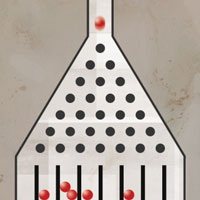| (Nanowerk News) In early 2011, a pair of theoretical computer scientists at MIT proposed an optical experiment that would harness the weird laws of quantum mechanics to perform a computation impossible on conventional computers. Commenting at the time, a quantum-computing researcher at Imperial College London said that the experiment “has the potential to take us past what I would like to call the ‘quantum singularity,’ where we do the first thing quantumly that we can’t do on a classical computer.” | |
 The experiment involves generating
individual photons — particles of light — and synchronizing their
passage through a maze of optical components so that they reach a
battery of photon detectors at the same time. The MIT researchers — Scott Aaronson,
an associate professor of electrical engineering and computer science,
and his student, Alex Arkhipov — believed that, difficult as their
experiment may be to perform, it could prove easier than building a
fully functional quantum computer.
The experiment involves generating
individual photons — particles of light — and synchronizing their
passage through a maze of optical components so that they reach a
battery of photon detectors at the same time. The MIT researchers — Scott Aaronson,
an associate professor of electrical engineering and computer science,
and his student, Alex Arkhipov — believed that, difficult as their
experiment may be to perform, it could prove easier than building a
fully functional quantum computer.In December, four different groups of experimental physicists, centered at the University of Queensland, the University of Vienna, the University of Oxford and Polytechnic University of Milan, reported the completion of rudimentary versions of Aaronson and Arkhipov’s experiment. Papers by two of the groups appeared back to back in the journal Science; the other two papers are as-yet unpublished.All four papers, however, appeared on arXiv, an online compendium of research papers, within a span of three days. Aaronson is a co-author on the paper from Queensland, as is Justin Dove, a graduate student in the Department of Electrical Engineering and Computer Science and a member of MIT’s Optical and Quantum Communications Group....MORE |
Friday, January 18, 2013
Multiple Steps Toward the 'Quantum Singularity'
From Nanowerk: